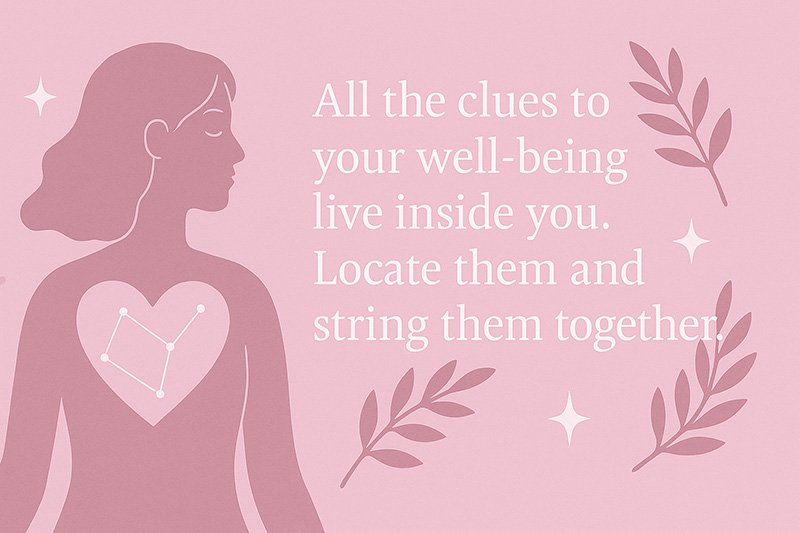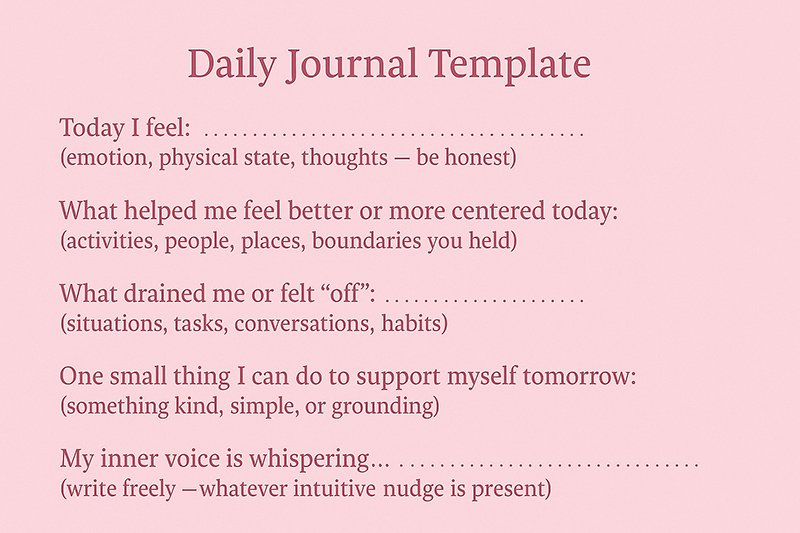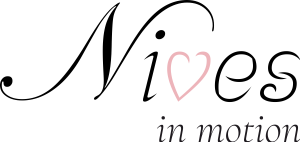
Mapping your inner compass
The other day, my astrology app served me a mantra that stopped me mid-scroll: “All the clues to your well-being live inside you. Locate them and string them together.” Poetic, right? A little cryptic too – which, let’s be honest, is kind of the vibe with astrology. (By the way, I’ve recently gotten into it, and it’s been such a fascinating rabbit hole – happy to share more if you’re into that kind of thing!)
Anyway, I was already in a bit of a soul-searching mood, so this line hit different and it left me wondering: What does that actually mean? How do I find those clues? And more importantly, how do I listen to them? What was clear for me: yes, it is an advice rooted in introspection. But what else and how can I incorporate it in my life? I decided to dig deeper. What followed was a personal experiment in learning to listen – not to podcasts, not to opinions, but to myself.
But first, let’s break down the meaning of the phrase that intrigued me so much:
- “All the clues to your well-being live inside you”: Your emotional, mental, and physical well-being depends on internal signals – your thoughts, feelings, body sensations, instincts, and inner wisdom. You already have the tools to understand what you need.
- “Locate them”: Pay attention to those internal signals. Notice what brings you peace or discomfort. Reflect on patterns in your behavior or feelings that influence your mood and energy.
- “String them together”: Make connections between those internal clues. For example, if you feel anxious when you’re around certain people or energized when you’re working on creative tasks, that information helps you understand what supports your well-being.
In short: Tune into yourself. You have insight within – you just need to notice it, connect the dots and let it guide how you care for yourself.
How do I do this ?
How do I tune into myself?
First of all, if this question emerges, it is already a great sign which shows you’re already tuned in or on a good frequency to do so. To “locate and string together” the clues to your well-being, here’s a practical, yet mindful approach which has helped me to get a better understanding of myself:
Pause & Listen to Yourself
- Daily check-in: Ask yourself, “How do I feel right now – physically, emotionally, mentally?” This can be any time of the day which allows you to sit still for a moment. Important: Try not to judge the answers (we tend to do that -I’ve been there 🙂 )
- Use body cues: Notice tension, energy, or fatigue. These are signals.
Identify What Supports or Drains You
- Reflect on your day : What activities, people, or thoughts made you feel calm, energized, anxious, or heavy? Obviously makes sense in the evening
- Write it down: Keep a simple log – even a few words help. Over time, patterns emerge.
Follow Your Inner Yes/No
- Your body often says “yes” or “no” before your mind does.
- Try this: when making a small decision (like whether to go out or stay in), close your eyes, imagine each option, and notice how your body reacts. Does one feel more spacious, lighter, calmer?
Journal Prompt (optional but powerful)
Try writing answers to:
- What helped me feel grounded today?
- What made me feel off-balance?
- What do I need more of? Less of?
Trust Small Clues (truly a gamechanger thought for me)
- Remember: You don’t need huge epiphanies. Tiny moments – like feeling calmer after turning off your phone, or more joyful after a walk – are valid and valuable.
Build a Personal Map
- Over time, you’ll begin to “string together” what truly supports you – your personal formula for well-being. Maybe it’s solitude + nature + structure. Or connection + movement + play. It’s unique to you and that’s what makes it special.
What really clicked for me through all of this? It’s not about the big, dramatic breakthroughs. It’s not some grand “aha” moment or life-altering question. The magic is in the tiny things – small signals, subtle shifts, baby steps. Over time, they start forming patterns. And those patterns? They’re gold when it comes to understanding what fuels us and what totally drains us.
Now, with my fast-paced, always-on-the-move F1 lifestyle, I know firsthand how easy it is to skip this kind of self-check-in with the classic excuse: “no time.” But let’s be real – we make time for the things we value. And this? This is worth valuing.
For me, these moments often happen during the in-between – a commute to the track or hotel, right before bed, or on slower mornings when we have evening races. Even on a plane (which is basically the universe’s way of forcing us to unplug), I’ll use that window to tune in instead of just zoning out. None of us has endless hours, but a little pocket of 3 – 5 minutes? That’s doable. Try my daily check-in – it’s low-pressure, easy to fit in, and trust me, it works. Personally, I love doing it at home on non-race weekends – the calm, familiar space makes it easier to drop in for me. But honestly, you can do it anywhere. Skip the eye-closing part if you need to. Headphones help 🙂
“Your inner compass is real - and it’s quietly guiding you all the time. The challenge is slowing down enough to notice it.”
Daily Check-In Practice (3 - 5 minutes)
1.
Get Still (1 min)
Sit quietly. Close your eyes if you like. Take 2–3 slow, deep breaths.
2.
Body Scan (1 min)
Mentally scan from head to toe. Ask: • Where am I holding tension? • How does my energy feel (tired, restless, calm, buzzy)?
3.
Emotional Pulse (1 min)
Ask: • What emotion is strongest right now? • What might be causing that feeling?
4.
Mind Check (1 min)
• What thought has been repeating today? • Is it helping or draining me?
5.
Inner Yes/No (Optional - depending on the day)
Bring to mind a decision or plan for today. Ask your body: • Does this feel like a Yes or a No? • What would bring me more peace right now?
If you don’t feel like following a step to step guide and just want to write straight from your soul, the following prompts might help to activate your thoughts:

Even just answering one or two of these can be incredibly grounding. No need to overdo it – this isn’t homework. It’s just a gentle way to tune in, build a bit of self-awareness, and honor where you’re at.
And that brings me full circle to where this whole reflection started…
What’s the takeaway from all of this soul-sleuthing?
Funny enough, this whole post started with a single thought – sparked by a random moment on an ordinary day, just me casually browsing my astrology app. One poetic little mantra popped up and suddenly I was down a rabbit hole of reflection, self-inquiry and daily rituals. That’s the power of paying attention. Sometimes, the most meaningful shifts begin with the quietest nudges.
Your inner compass is real – and it’s quietly guiding you all the time. The challenge is slowing down enough to notice it. Not to overanalyze it, not to fix anything immediately, but just to listen. And once you start picking up those subtle signals – your energy shifts, gut reactions, quiet nudges – you’ll be surprised at how much wisdom you already carry.
It’s a practice, not a performance. Some days, tuning in will feel effortless; other days, your mind will be all over the place (hi, we’re human). But like any muscle, the more you use it, the stronger it gets. You’ll start to recognize the patterns, build your personal toolkit and trust your inner yes – even when the outside world feels loud and chaotic.
Whether you’re in a packed paddock, a noisy airport lounge or curled up in your favorite corner at home, these tiny check-ins become anchors. They remind you who you are, what you need and where your peace lives.
So give yourself permission to pause. Start small. Be curious. And most importantly, let your inner voice take the wheel sometimes – it often knows the way before your brain catches up.
You’ve got the map. You’ve got the compass. You’ve always had both. Now’s just a beautiful time to start using them. ✨
With love, Nives
Download this article
If you like this article, you can save it for future


POST COMMENT